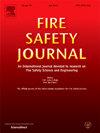Experimental and numerical investigation on the combustion behavior of densified wood: Differences among wood species and impact of char oxidation
Abstract
Densified wood (DW) is a novel structural material with promissing application potential in construction industry due to its excellent mechanical performance. However, it could also be a disastrous fuel contributing to the development of fires. This work experimentally and numerically investigated the combustion behavior of DW. The differences among wood species (fir, pine and oak) and their char oxidation impacts are emphasized. The experimental results indicate that DW has a 44.7 K lower pyrolysis peak temperature on average, a 32.2 % lower peak mass loss rate, and a 8 % higher residual mass ratio than natural wood (NW) in N2 due to the delignification process. The hemicellulose and cellulose pyrolysis are endothermic in N2 but exothermic in air. Wood pyrolysis has an additional char oxidation reaction in air. The higher density of DW leads to longer times for ignition and flaming combustion. DW presents a higher heat release rate and average 4.7 MJ kg−1 higher effective heat of combustion of char. Two parallel pyrolysis reaction schemes based on ambiance are proposed, which well-predict the microscale characterizations but fail to represent the combustion behavior. An optimized mode was developed by adding a continuous char oxidation reaction to the N2 reaction scheme, which best predicts the combustion behaviors.

 求助内容:
求助内容: 应助结果提醒方式:
应助结果提醒方式:


